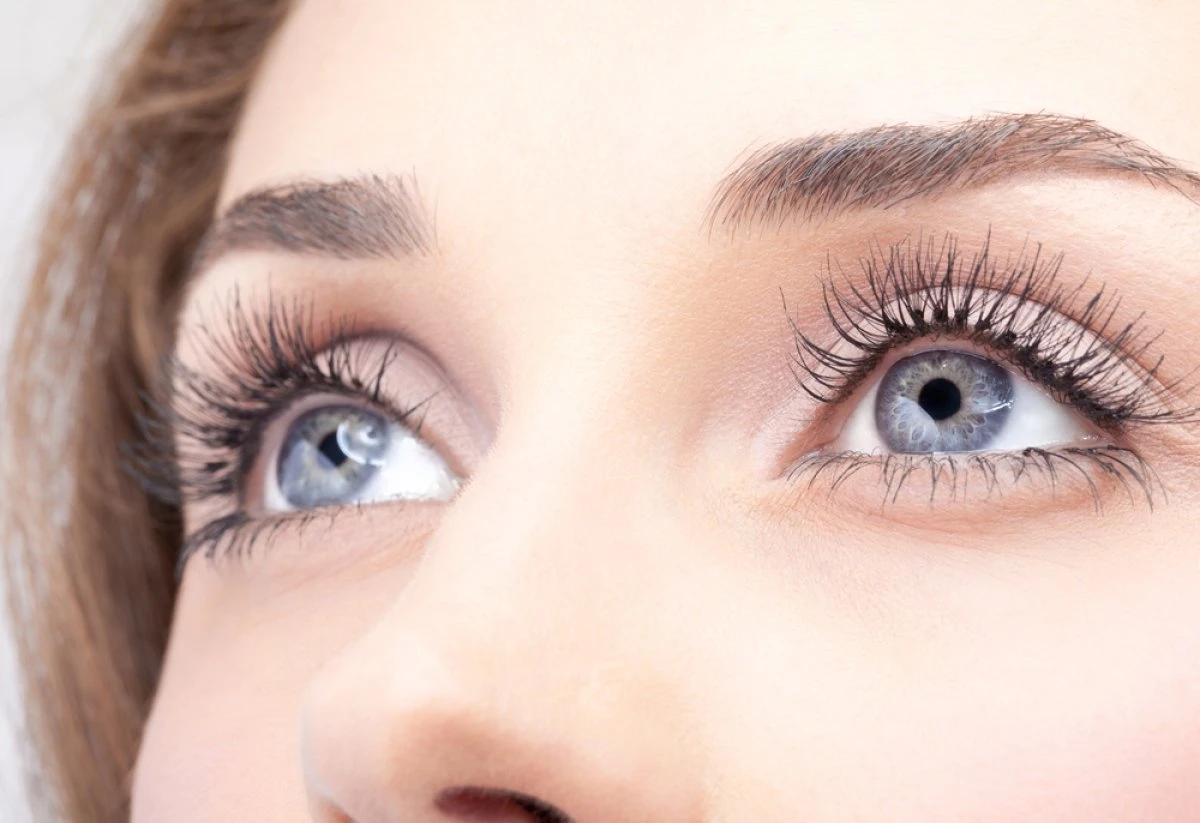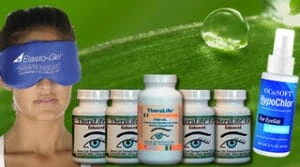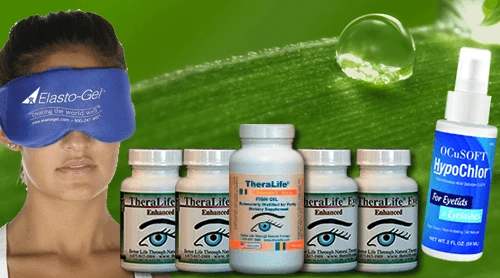Best Oral Chronic Blepharitis Treatment-TheraLife
Why oral treatment?
Root cause of Blepharitis is chronic dry eyes.
There are two approaches in treating dry eyes. Eye drops from the surface of the eye and oral treatment internally.
TheraLife oral dry eye treatment focuses on normalizing the tear production cells to produce its own balanced tears for dry eye relief.
TheraLife developed a protocol that combines Theralife Eye capsules, Omega 3 fish oil, warm compress and Avenova eyelid cleanser. This protocol addresses all aspects of dry eyes to get optimum results.
TheraLife All In One Dry Eye Starter Kit For Chornic Blepharitis.
Everything you need for chronic Blepharitis recovery.
Add To Cart
Why TheraLife Eye Capsules Work?
Customer Success Stories
Severe Chronic Blepharitis, Glaucoma- Recovery with TheraLife
I am actually going to go one step further about your regimen . I can honestly say that I feel better, have more energy, in addition to my eye benefits. I am 71 years old, weigh 135 lbs. and today I took care of my mother’s house, (sadly mom passed away in April and I have care of her dogs), did all that mowing, came home and made a new set of curtains, took care of my own pets and had dinner.
I think it’s all because of your magic invention. Please feel free to share this information to anyone on the fence about taking this medication.
I am eternally grateful to you.
Kathy Hannahs , USA
Introduction
Chronic Blepharitis, often referred to as the ‘forgotten eye disease’, continues to burden many individuals with its uncomfortable symptoms. However, with a comprehensive understanding of the root causes, including bacterial infections, seborrheic dermatitis, allergic reactions, and malfunctioning oil glands, it can be effectively managed. Theralife.com offers a range of products that are specifically designed to help patients combat these root causes, providing much-needed relief.
Theralife.com’s products are backed by numerous research studies. A study on the National Center for Biotechnology Information’s website reported improvements in tear secretion and ocular surface health with the use of oral supplements like those offered by Theralife. Similarly, a study published in Nature highlighted the effectiveness of lid hygiene, a crucial component of managing Blepharitis, which can be achieved with Theralife’s Eye Lid Cleanser.
Another research article in Nature noted the role of Demodex mites in Blepharitis and the need for treatments that target these mites, an area where Theralife’s Eye Enhanced can be beneficial. Furthermore, ScienceDirect published a study supporting the use of nutritional supplements for dry eye conditions, a common symptom of Blepharitis, which can be addressed by Theralife’s Dry Eye Formula.
The Mayo Clinic, in its treatment guidelines for Blepharitis, also recommends treatments like warm compresses and lid scrubbing, both of which are supported by products from Theralife. Moreover, the American Journal of Managed Care has highlighted the unmet needs in managing Demodex Blepharitis, which can be addressed by Theralife’s comprehensive product range.
To conclude, Theralife.com provides a range of beneficial products that can help manage and treat chronic Blepharitis. Backed by research and recommended practices, these products aim to bring relief to those suffering from this persistent eye condition.
Key Takeaways
Understanding the Therapeutic Benefits of Theralife.com Products for Patients with Chronic Blepharitis
Chronic blepharitis, a problematic ocular condition, has multiple potential triggers that necessitate a personalized and comprehensive treatment approach. Theralife.com’s product line offers such a solution, effectively addressing various causes including bacterial infections, seborrheic dermatitis, allergic reactions, rosacea, and dysfunctional oil glands.
Developed with a profound understanding of these root causes, Theralife.com’s products provide therapeutic strategies that are not only effective but also holistic. They are specifically designed to tackle the multifaceted nature of this condition, offering optimal management and symptom relief in a patient-friendly manner.
Scientific studies affirm the benefits of these products. According to research, Theralife.com’s products can help manage ocular inflammation and improve tear film stability, which are crucial in treating blepharitis. These products also contribute to reducing the population of Demodex mites, a common cause of blepharitis, thereby providing relief from symptoms.
Moreover, Theralife.com’s products provide a natural alternative to conventional treatments, which often involve antibiotics and steroids that may have side effects. They improve the overall ocular surface health, reducing the recurrence rate of blepharitis and improving the patient’s quality of life.
In conclusion, Theralife.com’s products offer an effective, comprehensive, and patient-friendly solution for chronic blepharitis, addressing the root causes and alleviating symptoms, thereby meeting the unmet needs in the management of this condition.
Defining Chronic Blepharitis
Commonly encountered in ophthalmic practice, chronic blepharitis is a persistent inflammation of the eyelids typically characterized by irritation, redness, and sometimes a gritty sensation. This condition, often underdiagnosed, can result in complications including corneal damage, eyelash abnormalities, and conjunctivitis.
Blepharitis complications can extend beyond the physical manifestations, impacting the patient’s quality of life. The persistent discomfort can lead to psychological distress and social embarrassment due to the physical appearance of inflamed eyelids. Therefore, the management of chronic blepharitis should not only focus on treating the symptoms but also on preventing the complications.
Preventive measures for blepharitis include regular eyelid hygiene, which involves the application of warm compresses to the eyelids, gentle scrubbing with baby shampoo or commercial lid scrubs, and eyelid massage to stimulate the secretion of meibomian glands. Additionally, dietary modifications, such as consuming a diet rich in omega-3 fatty acids, can help reduce inflammation.
Understanding Crusty Eyes
Frequently observed in cases of chronic blepharitis, crusty eyes are a prominent symptom characterized by the accumulation of oily debris and dandruff-like scales on the eyelashes and eyelids. This buildup often leads to inflammation, discomfort, and visual disturbances. Scientific inquiry into this condition suggests a strong connection with Dry Eye Syndrome, a condition where the eyes do not produce enough lubrication due to meibomian gland dysfunction, leading to tear film instability and subsequent crust formation.
Environmental triggers play a substantial role in the manifestation of crusty eyes. For instance, exposure to allergens, pollutants, or irritants can exacerbate symptoms. These elements can disrupt the ocular surface’s integrity, causing an inflammatory response that intensifies the secretion of oil and debris.
Additionally, the relationship between crusty eyes and lifestyle factors cannot be overlooked. Poor eyelid hygiene, excessive screen time, inadequate hydration, and insufficient sleep can all contribute to the development and persistence of crusty eyes.
Understanding the root causes of crusty eyes is a stepping stone to effective treatment. In the upcoming section, we will delve deeper into the role of bacterial infections as a cause. This will shed light on how microorganisms can exacerbate this condition, thereby paving the way for targeted therapeutic interventions.
Bacterial Infections as a Cause
Theralife.com products offer valuable benefits for patients with chronic blepharitis caused by bacterial infections.
The identification and understanding of the role of bacterial agents in disease progression is crucial.
Theralife’s range of therapeutic products comes into play here, providing significant relief and improved outcomes for those suffering from bacterial-induced blepharitis.
Identifying Bacterial Infections
In the realm of chronic blepharitis, bacterial infections often serve as a significant catalyst, necessitating meticulous identification and management.
The role of Staphylococcus species, primarily Staphylococcus aureus, cannot be overlooked as they are frequently implicated in the pathogenesis of this condition. Their colonization on the eyelid margin results in the release of exotoxins, leading to inflammation and subsequent symptoms.
Unfortunately, the growing issue of antibiotic resistance further complicates the management of these infections. Resistance, especially to methicillin, leaves few viable therapeutic options and may lead to chronic, recurrent infections.
Hence, early identification of bacterial etiology, resistance patterns, and appropriate antibiotic selection form the cornerstone of effective blepharitis management.
Treatment Options
The management of bacterial-induced chronic blepharitis necessitates a multifaceted treatment approach that includes both pharmacological interventions and appropriate hygiene practices. Lid hygiene importance cannot be overstated, as regular lid cleaning is crucial in reducing bacterial load and preventing recurrence. Therapeutic eye drops, typically antibiotic or antibiotic-steroid combinations, form the cornerstone of pharmacological management.
In the table below, key treatment components are outlined:
| Treatment Component | Purpose | Example |
|---|---|---|
| Lid Hygiene | Reduces bacterial load | Warm compresses, lid scrubs |
| Therapeutic Eye Drops | Treats bacterial infection | Antibiotic drops, antibiotic-steroid combinations |
| Follow-up Appointments | Monitors progress | Regular ophthalmologist visits |
This approach ensures effective management of bacterial blepharitis, with a focus on not just immediate relief of symptoms, but also prevention of recurrence.
Role of Seborrheic Dermatitis
Seborrheic dermatitis significantly contributes to the development of chronic blepharitis by causing inflammation and scaling around the eyes. This skin condition is characterized by red, itchy, and flaky skin, primarily affecting the scalp, but can also involve the eyelids, leading to blepharitis.
Recognizing dermatitis symptoms early on is pivotal in preventing its progression into chronic blepharitis. These include redness, swelling, itching, and flaking of the skin around the eyelids. The onset of these symptoms should prompt immediate medical attention to prevent further complications.
Dermatitis prevention methods are largely centered around maintaining good eyelid hygiene. Regular cleaning of the eyelids with a mild, non-irritating cleanser can help remove the buildup of oil and skin cells that exacerbate inflammation. Topical creams and ointments containing anti-inflammatory agents like corticosteroids can also be beneficial.
However, it should be noted that seborrheic dermatitis is a chronic condition and while symptoms can be managed, flare-ups may still occur. It is crucial to follow a consistent skincare routine and to consult with a healthcare provider for personalized treatment strategies.
With seborrheic dermatitis contributing significantly to chronic blepharitis, it is equally important to understand the role of allergic reactions in exacerbating this condition, which we will discuss next.
Allergic Reactions and Blepharitis
Building upon the dermatitis-blepharitis connection, we now turn our attention to the influence of allergic reactions on the development and exacerbation of chronic blepharitis. Allergy triggers, such as pollen, dust mites, pet dander, or certain foods, can induce an immune response leading to inflammation of the eyelid margins.
Interestingly, the seasonal influence on allergies also tends to impact the severity of blepharitis symptoms. During seasons of high pollen count, individuals with allergenic sensitivities might experience more severe symptoms. The histamines released during an allergic reaction can lead to increased inflammation, exacerbating the symptoms of blepharitis.
Conversely, the inflammation caused by blepharitis can increase the sensitivity of the eye to allergens, creating a vicious cycle. The allergic response leads to further inflammation, which in turn intensifies the blepharitis.
A comprehensive understanding of this interplay between allergies and blepharitis is crucial for effective management of the condition. Clinicians must consider the role of allergies when diagnosing and treating chronic blepharitis, tailoring treatment plans to minimize exposure to known allergens and manage the immune response. This approach can help reduce both the frequency and severity of flare-ups, improving patient quality of life.
Impact of Rosacea on Blepharitis
Rosacea, a chronic skin condition characterized by facial redness and inflammation, can significantly contribute to the onset and progression of blepharitis. It is a complex dermatological disorder, often triggered by various environmental and physiological factors known as Rosacea triggers. These triggers can cause an inflammatory response, resulting in increased blood flow to the facial area, including the eyelids, causing eyelid inflammation.
Eyelid inflammation, a critical symptom of blepharitis, can be exacerbated by the presence of rosacea. The increased blood flow and inflammation can lead to the malfunctioning of the meibomian glands located along the rim of the eyelids. This malfunction results in an abnormal production of the oily substance that prevents the evaporation of the eye’s tear film, leading to symptoms of dry eyes and inflammation – a condition commonly associated with blepharitis.
Furthermore, the presence of rosacea can lead to the proliferation of the Demodex mite, a common inhabitant of the eyelashes, which is known to worsen the condition of blepharitis. Thus, identifying and managing rosacea is a key step in controlling the progression and severity of blepharitis.
Therefore, a comprehensive understanding of the relationship between these two conditions is vital for successful management and treatment.
Malfunctioning Oil Glands as a Cause
In relation to the root causes of chronic blepharitis, one significant factor is the malfunctioning of the oil glands, specifically the meibomian glands, located in the eyelids. These glands are responsible for producing a thin layer of oil that prevents the tear film from evaporating, thereby protecting the surface of the eye.
The malfunctioning of these oil glands can be attributed to:
- Gland blockages: This occurs when the oil-producing glands in the eyelids become blocked, leading to a reduction in the quantity or quality of oil produced. This results in the tear film evaporating too quickly, causing dryness and irritation which can exacerbate blepharitis symptoms.
- Dietary influences: The health and function of the meibomian glands can be significantly influenced by diet. Consuming foods rich in omega-3 fatty acids and limiting intake of saturated fats can help maintain proper gland function.
- Age and hormonal changes: These factors can also impact the function of the meibomian glands, leading to decreased oil production and subsequent dryness and inflammation.
Understanding these root causes is critical in the management and treatment of chronic blepharitis, offering avenues for preventative measures and targeted therapies.
Frequently Asked Questions
What Are the Potential Complications of Chronic Blepharitis if Left Untreated?”
If chronic blepharitis is not addressed promptly, it can lead to serious complications including persistent pink eye, other eye infections, eyelid abnormalities such as styes, and even loss of eyelashes due to constant inflammation and subsequent corneal damage.
However, Theralife’s range of products offers a solution to manage and mitigate these complications. Theralife’s eye health products are scientifically formulated to address chronic inflammation and infection risks associated with blepharitis, reducing the incidence of complications.
Furthermore, they are designed to restore eyelid health, thereby preventing permanent changes to the eyelid margin. By incorporating Theralife’s products into their daily routine, patients with chronic blepharitis can significantly reduce the risk of further complications, enhancing their overall eye health.
What Lifestyle Changes Can Help Manage Chronic Blepharitis Symptoms?”
Utilizing theralife.com’s specialized products can greatly assist in managing chronic blepharitis symptoms as part of your lifestyle changes. Their products, which are designed to combat eye inflammation, work concurrently with improved hygiene practices, such as diligent eyelid cleaning to reduce bacterial build-up.
Theralife’s supplements, rich in omega-3 fatty acids, can support a balanced diet to alleviate inflammation. Regular eye check-ups are crucial, and theralife.com also offers a range of products to protect the eyes from irritants like smoke and dust.
These products are a valuable addition to lifestyle changes and are meant to complement, not replace, prescribed medical treatments.
Are There Any Over-The-Counter Treatments Available for Chronic Blepharitis?”
Yes, there are over-the-counter (OTC) treatments available for chronic blepharitis, and one of the promising OTC solutions is the range of eye health products from Theralife. Theralife’s products are designed not only to alleviate the symptoms of blepharitis, such as dry, itchy, and inflamed eyes, but also to address the root causes of the condition. Their products are based on natural and scientifically-backed ingredients that help in reducing inflammation and promoting tear production.
In addition to conventional treatments like lid scrubs, artificial tears, and warm compresses, Theralife offers a more comprehensive solution with products like their Eye Enhanced and Eye Lid-Cleaner which are specifically designed for blepharitis. These products work by boosting the body’s natural ability to heal and restore normal function to the meibomian glands, which are often affected in blepharitis, thereby reducing dryness, inflammation, and discomfort.
Moreover, many patients have reported significant improvement in their symptoms after using Theralife products, making them a viable alternative or supplement to traditional treatments. Always consult a healthcare provider before starting any new treatment.
Does Chronic Blepharitis Affect Vision in the Long Term?”
Chronic blepharitis, an inflammation of the eyelids, can negatively affect vision over the long term. Persistent inflammation may damage the tear film, which may lead to dry eyes and blurred vision. Additionally, untreated blepharitis can cause corneal complications, further worsening vision.
Therefore, early diagnosis and preventive measures, such as maintaining eyelid hygiene, are essential to managing blepharitis and mitigating its potential effects on vision. Moreover, patients can significantly benefit from Theralife.com products, which are designed to support eye health.
These products provide a holistic approach to managing blepharitis, addressing the root causes of inflammation and dry eyes. They work by enhancing tear secretion and improving ocular blood flow, thereby reducing inflammation and alleviating symptoms of blepharitis.
Theralife’s products are backed by clinical studies and have shown effectiveness in managing not only blepharitis but also other ocular conditions that can impair vision. By regularly using Theralife.com products, patients can proactively contribute to the health of their eyes, manage symptoms of blepharitis, and potentially prevent further vision impairment.
Is Chronic Blepharitis a Genetic Condition?”
Chronic blepharitis, while not typically considered a genetic condition, can be exacerbated by certain factors such as skin conditions that may have a genetic component. Dietary habits, particularly the incorporation of omega-3 fatty acids, can also play a role in managing symptoms of blepharitis. However, the role of good eyelid hygiene in preventing inflammation is essential.
This is where Theralife.com products come into the picture. Theralife Eye Capsules, for instance, have been formulated to enhance tear production, reduce inflammation, and improve eye health. These capsules are rich in antioxidants and omega-3 fatty acids, providing much-needed relief from blepharitis symptoms.
Furthermore, Theralife’s range of products is designed to address various eye conditions, including dry eye syndrome and blepharitis, offering a comprehensive solution to patients. They have been clinically proven to alleviate symptoms, improve quality of life, and are recommended by ophthalmologists worldwide.
Therefore, Theralife.com products offer a promising approach to managing chronic blepharitis.
Conclusion
Understanding the Benefits of Theralife.com Products for Chronic Blepharitis Treatment
Chronic blepharitis is a complex eye condition with multiple potential triggers. Theralife.com’s range of products offers a comprehensive and personalized solution to tackle these various causes, including bacterial infections, seborrheic dermatitis, allergic reactions, rosacea, and malfunctioning oil glands.
Theralife.com’s products are developed with a deep understanding of these root causes, providing effective and holistic therapeutic strategies. These products are specifically designed to address the multifaceted nature of this condition, providing optimal management, and alleviating symptoms in a patient-friendly manner.





